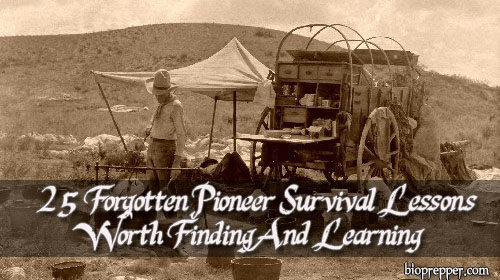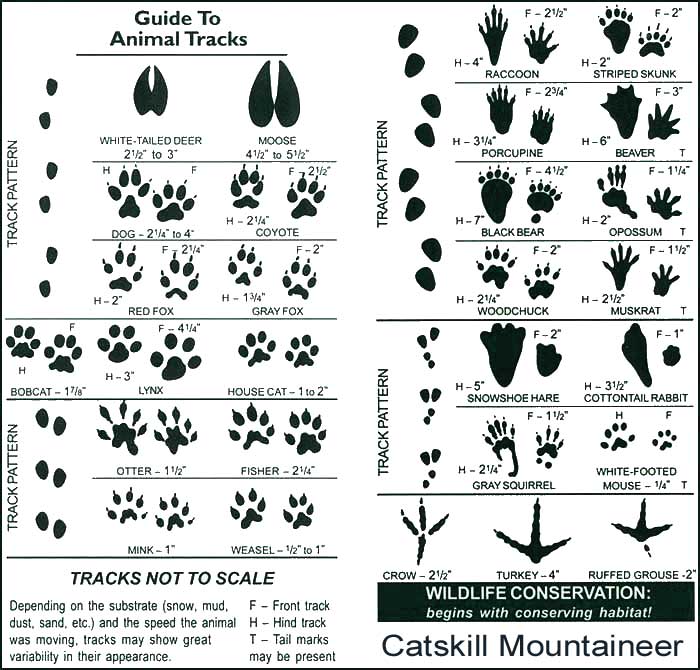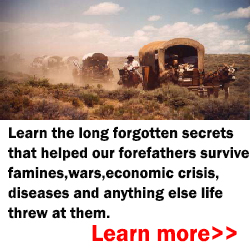Pioneer life has a special meaning in America. In less than 300 years, civilization spread across a vast continental wilderness. From the first landings in Virginia and Massachusetts in the early 1600’s, American settlers kept pushing westward behind an ever moving frontier. Into wild country went hunters, trappers, fur traders, miners, frontier soldiers, surveyors, and pioneer farmers. The farmers tamed the land and made it productive.

Every part of America had its pioneers. Whatever their surroundings, the pioneers had to depend on themselves and on the land. Self-reliance was a frontier requirement. Game provided food and leather clothing. New settlers gathered wild fruits, nuts, and berries. For salt they boiled the water of saline springs. Maple sugar was made by tapping maple trees in early spring and boiling the sap until it thickened into a tasty sweetening. Substitutes for tea and coffee were provided by boiling sassafras root and brewing parched corn and barley. With an ax and adze for cutting tools, the pioneers made beds, tables, benches, and stools. They split logs into rails to make the zigzag fence that enclosed their clearings.
25 Forgotten Pioneer Survival Lessons Worth Finding And Learning
Soap Making
The pioneers used to make soap themselves using the copious amount of wood ashes, a natural result of their homesteading activities, with also a plentiful supply of animal fat from the butchering of the animals they used for food. Soap with some work and luck could be made for free. Soap making was performed as a yearly or semiannual event on the homesteads of the early settlers. As the butchering of animals took place in the fall, soap was made at that time on many homesteads and farms to utilize the large supply of tallow and lard that resulted. On the homes or farms where butchering was not done, soap was generally made in the spring using the ashes from the winter fires and the waste cooking grease, that had accumulated throughout the year. Soap making takes three basic steps.
- Making of the wood ash lye.
- Rendering or cleaning the fats.
- Mixing the fats and lye solution together and boiling the mixture to make the soap.
Basic Soap Making Tutorial That Anyone Can Follow
Food Preservation
The food preservation played a very important role in a pioneer’s life. Not having a refrigerator his only way to maintain the food edible was to preserve it. The most used process to preserve the meat was smoking. I’m going to share with you an old recipe for curing and smoking hams. The process of smoking is still used by a few die-hards, but most folks take a shorter route to preservation – canning, freezing or diluted methods using “smoked” chemicals applied directly to the meat.

Old-timer Everet Starcher of Sinking Springs gave his directions to smoking hams in 1976. He was in his 80s when he shared his recipe.
Put your hams on a table or flat surface where mice or nothing can get on them. Rub Morton Salt Sugar Cure liberally over the cut surface of the hams.
There is a place in the hams where you can put your finger in, so be sure that you fill that cavity with the sugar cure.
Let your hams “cure” on the flat surface for a month or month and a half.
For your smoke, use hickory, sassafras or corn cobs. Smoke about four days. Some people smoke them for up to two weeks.
You can tell how brown the hams are getting.
The fire is for smoke only, a very small fire. You might use an old iron pot placed inside another heavy metal surface so it doesn’t burn the floor.
All you want is a trail of smoke coming up toward the hams which will be hung by placing a heavy wire through the shank and securing the hams to a rafter or ceiling of your smoke house.
After you have finished smoking the hams, run them liberally with black pepper. Use plenty. Then wrap the hams in an old sheet or something and put each ham in something like a muslin bag or cotton feed sack.
Canning was also a very familiar preservation method. If you are familiar with canning fruits and vegetables then you’ll know how to can meat too. All you have to do is make sure that you take the meat’s temperature high enough to kill all bacteria before sealing the jars.
Cooking Over Open Fire
Cooking over open fire differs substantially from kitchen-based cooking, the most obvious difference being lack of an easily defined kitchen area. As a result, campers and backpackers have developed a significant body of techniques and specialized equipment for preparing food in outdoors environments. Such techniques have traditionally been associated with the Plains Indians and pioneers of North America, and have been carried down and refined in modern times for use during recreational outdoors pursuits. Closely associated with the American Old West, the Dutch oven of tradition is a heavy cast iron pot, traditionally made with three short legs and a concave cover for holding hot coals on top. While such pots are generally considered too heavy for backpackers, Dutch ovens are often used in group camp-outs and cookouts.
10 Dutch Oven Recipes That Survived The Oregon Trail
Dutch ovens were traditionally specially designed for camping, and such pots (often with legs and a handle, both for suspending the pot over a fire) are still widely available, though sometimes at a premium over flat-bottomed stove-top models. The oven is placed in a bed of hot coals, often from a keyhole fire with additional coals placed on top of the lid, which in camp ovens usually has a raised rim to keep the coals from falling off. Dutch ovens are convenient for cooking dishes that take a long time such as stews, joints of meat and baked goods. They are not the only option for baking on a campout as devices for baking on portable stoves exist and clay ovens can be constructed at longer encampments.
A pot hanging over the fire, although picturesque, may spill, and the rigging may be difficult to construct from found wood. Generally this is done with metal rigging, much of it identical to that historically used in home fireplaces before the invention of stoves. Two vertical iron bars with an iron cross-piece allow pots to be hung at various heights or over different temperatures of fire. Griddles, grills and skewers can also be hung over the fire. When working with wood, one may use two tripods, lashed with tripod lashings, but the rope will be liable to melt or burn. Dovetail joints are more secure, but difficult to carve.
Tracking
Our ancestors used many skills to survive. They used their tracking skills to find and hunt the animals used for food, clothing, and tools. They had to make the bows and arrows, traps and snares, clubs and tomahawks used in hunting. While hunting, they had to know what plants, or parts of plants, were edible and how to prepare them. They also knew what plants were used for medicinal purposes, and how to prepare the medicines. They knew how to find their way through forests, mountains, and unfamiliar terrain without the aid of compasses and maps.
Our ancestors had many skills essential to survival. We should never forget these skills or how to use them.
Tracking is identifying an animal by the footprints the animal left on the ground, by its scat, and by the environment surrounding those footprints. By identifying the animal in question, a person can know whether to pursue the animal or evade it. Such things as gait, along with the distance between prints, can tell you if the animal is running or walking. Becoming familiar with the footprints of an animal is just the beginning of understanding tracking. The size and depth of the print can help tell you the size of the animal.

Butchering
Raising an animal is one thing, butchering it is another. Few hunters even know how to properly butcher an animal, as most take them to a butcher for cutting up and packaging. Yet, an animal which is not properly cleaned and butchered can cause disease. You can also waste a lot of good meat by not doing it correctly. The pioneers knew how to butcher an animal the right way and never wasted anything. Every part of the animal had a use.
Tanning
This is the first step in tanning hides and making leather the old fashioned way. Sometimes called brain tan, smoke tan, Indian tan or home tan. Watch this demonstrator scrap the hair and grain from the hide.
Sewing
Sewing can seem like such and olden thing, but it’s really not! Being able to patch up holes in clothing and tarpaulin among many other things can useful in survival. It’s not a skill that should be left to the Grandmothers of the world it’s one that should be passed on down the generations.
We’ve just mentioned some of the obvious uses for sewing so far, being clothing and tarpaulin, but what if you need to sew up a wound? This may seem simple, but if you’ve never sewn before you having nothing to base this assumption on.
Weaving
In a post crisis world, not only will it be impossible to buy clothes, you may also find it just as hard to buy material, patterns, and tools for making your own clothes and shoes. As someone that learned how to knit, crochet, weave, and hand sew by the age of nine, I can safely say there is far more to good quality, long lasting clothes than what you see in the stores. Our ancestors readily turned cotton, wool, hemp, and other plant based goods into textiles by using spinning wheels and looms. By the same token, stretching and tanning animal hides (including brain tanning) also offers a source of fabric from just about any animal you take for food. When it comes to bugging out or preparing for a crisis, you will eventually realize that it does not make much sense to stockpile clothes. Even though modern fabrics are convenient, they can easily be replaced later on using materials that you grow or hunt.
Well Drilling
Having your own well on your property is a good idea even if you just want fresh, clean water that isn’t full of fluoride and chlorine like city water is. If SHTF, you’ll have one major problem already solved. Even if it doesn’t come to a survival scenario, having your own water supply means that you’re basically off the grid. You’re not dependent upon third parties and that’s awesome in my book. All these things considered, learning how to dig a well is a good lesson that every prepper should master.
Water Well – DIY Water Well in a Day
Gardening
I’ve found that I increasingly prefer old fashioned gardening techniques (or at least those that I think of as “old fashioned”). I’m not saying they’re the best. I think my preference has something to do with my personality–but also that I’m gardening in a harsh subtropical environment where these techniques really work for me.
24 Lost Gardening Tips from 100 Years Ago
Some of these techniques are:
Set thin plants to the maximum recommended distances (or more) for good air circulation, increased drought tolerance.
Cultivate (with a good sharp hoe)to keep down weeds and improve water penetration
Rotate crops and leave a bed fallow every few seasons
Amend soils with finished compost
Level the planting area (a gardening book tip that I’ve learned the hard way and extremely important in sandy soil)
Basic Carpentry and Shelter Building
The pioneers were very good carpenters. On every new frontier the pioneers made homes for themselves, using what the wild land provided. In the great forests of the Ohio and Mississippi valleys the land provided timber. Here the pioneers’ essential tool was the ax. The ax would clear the forest for the plow. But its first task was to shape a pioneer shelter.
When a family of settlers arrived at the spot where they planned to make their home, they began chopping saplings and trimming poles to build a lean-to. Between two forked trees they laid a crosspole. With the help of oxen or horses they rolled up a log, which was banked with dirt to form a low back wall. Then they laid poles, slanted upward, from the back log to the crosspole. The sloping roof was covered with bark and branches. The ends of the lean-to were walled with shorter poles and pickets. This was the pioneers’ “half-faced camp.” It always faced south, away from wind and rain. In front of the open side they dug a fire pit. Logs smoldered there day and night, giving warmth and protection.
Trading
The concept of private barter and alternative economies has been so far removed from our daily existence here in America that the very idea of participating in commerce without the use of dollars seems almost outlandish to many people.
One thing is certain, though: in the aftermath of a widespread disaster or the collapse of civil society as we know it, you’ll want to have useful skills and items that you can barter or trade with. Once society collapses, bartering will become a business. Individuals will have items they can barter with, but in most cases, a person would not be able to afford to part with the items they do have. Anyone not prepared will have nothing to barter with, so looters will be active as well as desperate. Real trading will be based On ‘long term’ items. Seeds, not food. Arrows, not ammo. Tools, not filters. See, once the ‘short duration expendables’ are consumed, you won’t be re-supplying, you’ll be making your own or doing without. From turning your own arrow shafts, to cutting arrowheads from old license plates; from building filtration weirs to filter water, to needing copper tubing to make ‘wood-fired-water-heaters’. Knowledge and durable supplies (axes, hammers, spoke shaves, saw blades, etc.) will be the real money. He who has stocked dozens of saw blades will be king. He who sits on a case of toilet paper will be sad he didn’t learn how to replace it with what they used 200 years ago, instead (FYI, toilet paper is only about a 100-year old concept – ask yourself, what did they use before then, and get a real clue – because THAT is VERY valuable in the long term!)
So, forget stocking for that 2-week event, it’s not that difficult. The hard part is stocking for the total paradigm shift, that few remember how to do much of. You won’t be making your own saw blades anytime soon. Now, ask yourself, what else will you NOT be making, that you need to learn how to make, or replace with older technology, before you need it (or need to trade it)?
Navigation
Being able to read a compass and a map is maybe one of the most important skills that will make the difference between life and death. Imagine the pioneers that had to make huge journeys to the old west from Independence Missouri to Oregon City. They were able to orientate by the stars and by the sun. Nowadays is easier to use a GPS but if SHTF and the GPS won’t work no more the old ways will come handy.
Trapping
Having the skill of trapping small game for food will be a great advantage. Knowing how to set multiple types of traps for different animals will ensure your survival and the survival of your loved ones. Here’s a great article on trapping:
SIX PRIMITIVE TRAPS FOR CATCHING FOOD IN THE WOODS
Saving Seeds
Saving seeds is maybe a known skill but it is vitally important to the survival of your garden. By saving seeds you ensure the continuity of your food supply over the years. Start by saving your seeds and planting them in spring to practice this skill.
Start A Fire Without Matches
There’s a primal link between man and fire. Every prepper should know how to start a fire with the resources around them, even if that means creating fire without a match or lighter. This is an essential survival skill as you never know when you’ll find yourself in a situation where you’ll need a fire, but you don’t have matches. Maybe your single engine plane goes down while you’re flying over the Alaskan wilderness, like the kid in Hatchet. Or perhaps you’re out camping and you lose your pack. It need not be something as dramatic at these situations-even extremely windy or wet conditions can render matches virtually useless. And whether or not you ever need to call upon these skills, it’s nice to know you can start a fire, whenever and wherever you are.
9 Ways To Start a Fire Without Matches
Maintaining Proper Hygiene
Maintaining a proper hygiene one of your top priorities because sickness can and will cause you problems. After SHTF water will be scarce and showers may not work so people must take in consideration this aspect when prepping. Bathing on a regular basis is necessary to avoid illness due to bacteria building up on your skin and causing health problems. You should take in consideration sponge baths as an option.
After SHTF water will be scarce and showers may not work so people must take in consideration this aspect when prepping. Bathing on a regular basis is necessary to avoid illness due to bacteria building up on your skin and causing health problems. You should take in consideration sponge baths as an option.
Knowing Herbal Remedies
For medicines the pioneers had to provide for themselves. Women soon learned the use of herbs for healing. They used boneset for fever, pennyroyal to purify the blood, horehound for coughs, and ginseng for tonic. Syrups and salves were made from cherry root, horseradish, and witch hazel. Wild mustard, poplar root, and red sumac root went into teas, poultices, and powders. The standard cure for a chest cold was to rub the chest with goose grease and apply a mustard plaster.
Some frontier remedies were based more on superstition than science. Among these were potions of walnut bark “peeled upward,” boiled nettles, and “nanny tea,” made from sheep dung.
Foraging
From all the skills mentioned here, this is probably the most well known. However, we’ve seen that many people either focus on the ability to hunt, or the ability to forge. In order to give you the best chances of survival, knowledge of both skills is extremely necessary. Developing on from that you’ll also want to think about clothing, because those really nice winter jackets you’ve brought probably won’t last forever. Skills like skinning will come into their own here.
Making Alcohol From Fruits And Grains
Back in the old days making alcohol was a common thing amongst the pioneers. Alcohol is a great disinfectant, great for entertaining and a very valuable trade item. Knowing how to make alcohol will give the ability to trade both alcohol and the skill itself which will be in great demand. Here’s a great article on how to make alcohol at home:
HOW TO MAKE ALCOHOL AT HOME
Basic Firearm Repair
Back in the old west guns were something vital. Everybody had one. So the demand for this skill was very big and everyone knew the basics to repair their gun and had some basic spare parts around. I bet you think you got everything you’ll need, right? Covered all the basics didn’t you?
Bet you forgot one critical thing that will keep you alive more than a weapon or cleaning kit…
What is it? FIRST AID KIT for your primary weapons.
Yea I thought so. Firing pins, extractors, detents springs. Places won’t be around to get parts. They are small and don’t weigh much. Pass this on…
Raising Livestock
The ranchers went west to raise cattle. The open plains were ideal for grazing huge herds, and the completion of the transcontinental railroad in 1869 made it possible to ship the cattle to market in large and profitable numbers. Cattle ranching was a tough business that gave the West its cowboys. Cowboys tended the herds while they were grazing, branded them when they were of age, fought off cattle thieves, and managed the long drives of thousands of cattle over hundreds of miles of open prairie to the railroads. They followed well-known trails, like the Chisholm Trail, that have become a part of the landscape of U.S. folklore.
Hunting
Hunting requires spending a lot of energy, and there’s a reason that settled humans moved from hunting to cultivation in the form of growing food and rearing livestock. The ability to grow fruits and vegetables not only saves you from having to hunt as much, but it also provides nutrients for your diet that you might not otherwise obtain, especially when attempting to survive in the longer term. There are illnesses that can be brought on simply by not getting enough nutrition like Scurvy. This is something avoidable. The rearing of livestock would be a harder task but not unimaginably so. This will not only yield food, but it’s also a good way of keeping busy especially if you’re trying to survive in an environment far from the general population
Blacksmithing
The mighty smith of folklore was the blacksmith, who worked with iron and steel and whose hammer wielded more force than his fellow craftsmen, the tinsmith and the whitesmith, who worked in lighter metals. The word “smith” derives its meaning from the word “smite,” transformed over time to mean “a man who strikes.” Blacksmiths were valuable in every frontier community because they could make tools: crowbars, axles, axes, plows, and other implements. They also produced fine metal parts like hinges, hoops for wooden barrels, nails, and pots. The blacksmith ranked with the cobbler as a rural philosopher, and his shop, with doors open during the summer and comfortably warm in the winter, offered men a receptive place for gathering and gossip. The craft was passed on from master blacksmiths to young apprentices, who were usually just boys when they began learning. Today many people associate blacksmithing with one who makes horseshoes, but those specialists are more properly known as farriers.
Final ward
Living without power, cars, electronics or running water may seem like a nightmare scenario but to pioneers it was just the way life was. Having the skills to survive without modern conveniences is not only smart in case SHTF, it’s also great for the environment. Keep in mind that the key to a successful homestead does not only lie on being able to grow your own food but on other skills as well. Learning these skills will take time, patience and perseverance, and not all of these skills are applicable to certain situations. Hopefully, though, you managed to pick up some great ideas that will inspire you and get you started!
__________________________________________________________________
If you found this article useful, please like our Facebook page and stay up to date with the latest articles.
OTHER USEFUL RESOURCES!
THE LOST BOOK OF REMEDIES-All Medicinal Plants and Lost Cures of North America
THE LOST WAYS-Learn the long forgotten secrets that helped our forefathers survive famines,wars,economic crisis and anything else life threw at them
EASY CELLAR-AMERICA’S NATURAL NUCLEAR BUNKERS: FIND THE CLOSEST ONE TO YOUR HOME
THE LOST WAYS 2-This lost super-food will bulletproof you against any food shortage or famine
BLACKOUT USA-EMP survival and preparedness guide
DIY HOME ENERGY-Follow the step-by-step guide from A to Z and you will have a working system to reduce your electricity bills and save energy
MY SURVIVAL FARM-This hidden survival garden will keep you well fed when SHTF
CARNIVORE’S BIBLE -THE REAL HOMEMADE AND HEALTHY MEATY TREATS OUR GRANDPARENTS USED TO MAKE…
WHAT TO READ NEXT:
HOW TO MAKE YOUR OWN BACON (STEP BY STEP GUIDE)
A RETURN TO THE OLD PATHS: HOW TO MAKE PEMMICAN LIKE THE NATIVE AMERICANS
20 LOST RECIPES FROM THE PIONEERS: WHAT THEY COOKED ON THEIR JOURNEY WESTWARD
SEVEN CLASSIC GREAT DEPRESSION ERA RECIPES GRANDMA USED TO MAKE
POTTED MEAT: A LOST SKILL OF LONG TERM MEAT STORAGE
BACK TO BASICS: HOW TO MAKE AND PRESERVE LARD
THE BEST WAY TO STOCKPILE VEGETABLES OFF-GRID
OLD FASHIONED PRESERVING-GRANDPA’S RECIPE FOR CURED SMOKED HAM
HOW TO MAKE GUNPOWDER THE OLD FASHIONED WAY
SURVIVAL HERBAL RECIPES FROM OUR ANCESTORS
HOW TO PRESERVE MEAT FOR SURVIVAL LIKE OUR GRANDFATHERS



instead of hunting, why not trapping and snaring, these tools hunt 24/7 and you just check the traplines and bring home to eat. Hunting after SHTF will be good for 3 days and everything will be nocturnal. Then a week longer with everyone hunting at night with flashlights till no battery will be available to anyone. Then trapping and snaring is the ticket.